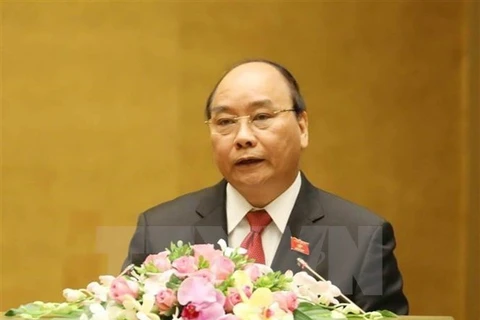 Experts and policy makers discuss policy solutions for 2018-2020 to boost growth model reform in Vietnam. (Photo: VNA)
Experts and policy makers discuss policy solutions for 2018-2020 to boost growth model reform in Vietnam. (Photo: VNA) Hanoi (VNA) – Experts and policy makers gathered at a forum held by the Central Institute for Economic Management (CIEM) in Hanoi on October 24, discussing policy solutions for 2018-2020 to boost growth model reform in Vietnam.
The forum took place as part of the macroeconomic reforms/green growth programme in Vietnam funded by the German Government via the German agency for international cooperation GIZ.
CIEM Director Nguyen Dinh Cung said it is necessary to immediately remove obstacles to accelerate the disbursement of state investment capital right from the beginning of 2018 to avoid a recurrence of the sluggishness in the last two years. He also urged better use of State-owned and private enterprises’ capital.
“The efficiency of foreign invested firms in Vietnam is very high, even three times higher than State-owned and private firms in terms of the return on invested capital. Therefore, it is crucial to improve domestic businesses’ competitiveness,” he analysed.
He suggested creating “pressure” for the elimination of at least one-third or half of the business conditions, and at least half of the number of goods subject to specialised export-import examination while reforming management methodology.
Another factor expected to promote Vietnamese goods’ competitiveness on domestic and foreign markets is slashing logistics costs, which will help improve the country’s export value chains, Cung noted, adding that relevant agencies also need to instruct and assist businesses to comply with regulations instead of fining them.
Nguyen Tham, former Vice Chairman of the Vietnam Logistics Business Association, said without positive changes and stronger solutions, the burden of unofficial expenses and logistics costs will greatly affect goods’ cost price. This will directly impact the country’s goods value chains and Vietnamese commodities’ competitiveness both at home and abroad.
Meanwhile, Dr Pham The Anh from the National Economics University said the exchange rate policy should be flexible to enhance Vietnamese goods’ competitiveness.
He elaborated that the State Bank of Vietnam began setting the daily reference VND/USD exchange rate in 2016 based on a currency basket of the country’s biggest economic partners, but this mechanism is not enough to support foreign trade activities. Vietnam’s exchange rate policy is still in a dilemma as it has to ensure inflation control along with public debt stability and trade promotion.
A floating exchange rate mechanism under management will bring about more benefits than the current fixed one. However, this mechanism still needs certain conditions to be applied and prove effective, Anh added.
Only when bottlenecks are removed and new growth momentum is created can sustainable development be promoted, according to participants in the forum.-VNA
VNA























